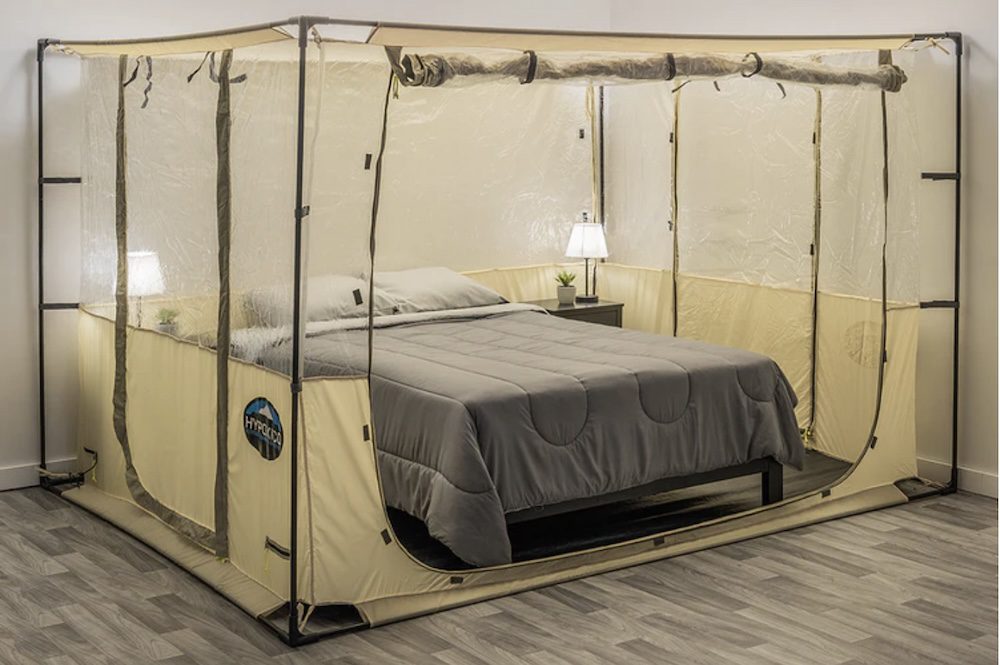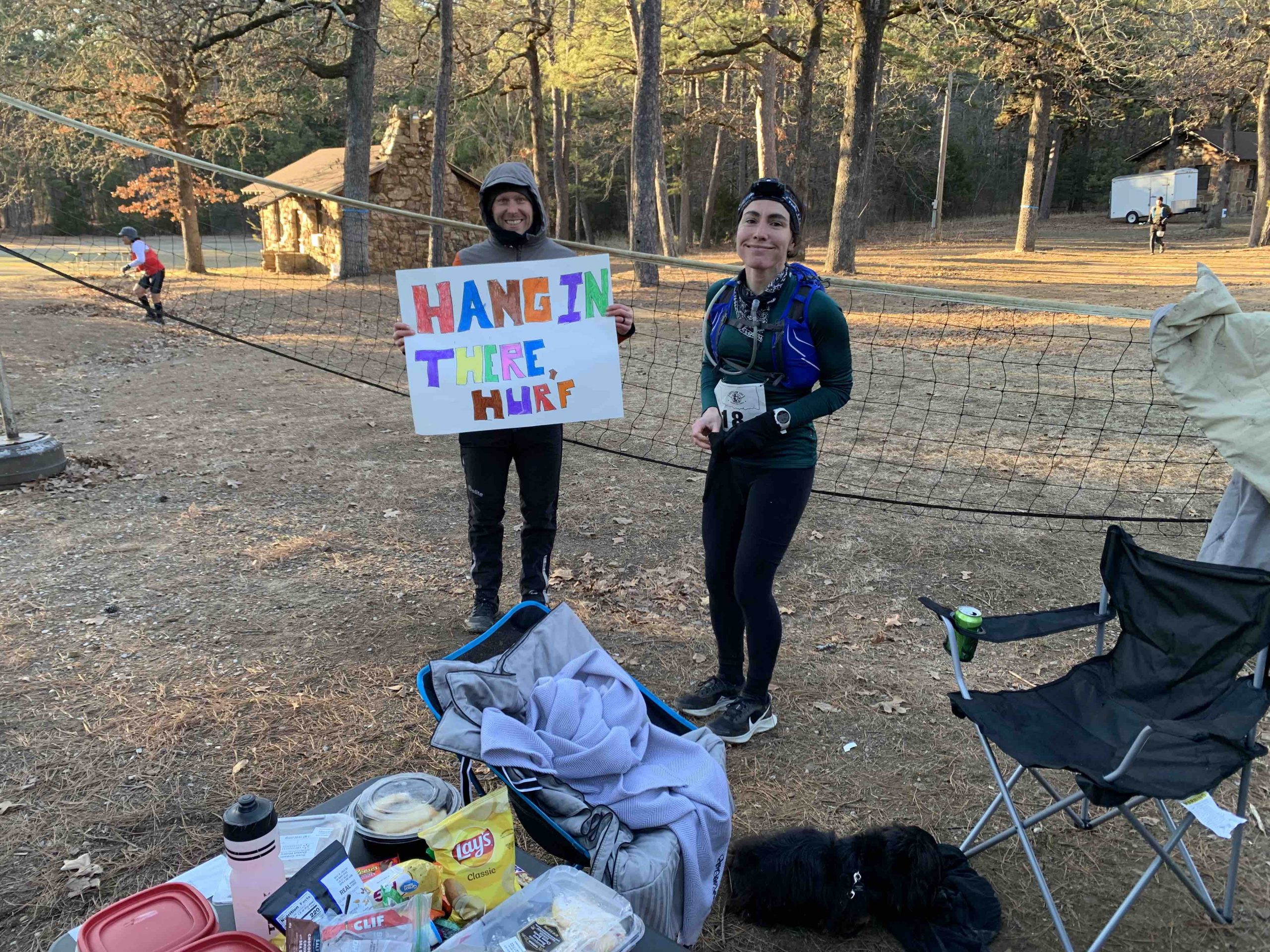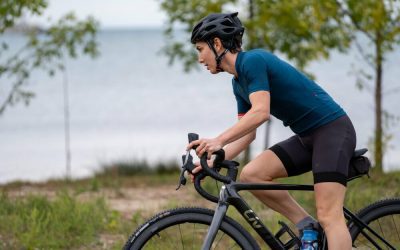Sleeping in an Hypoxico altitude tent
Sharing an altitude tent (sorry, altitude cubicle) with a partner is asking a lot of your relationship. Let’s just start right there. If you’re someone living at 0 feet of elevation and planning to race, say, at the 10,000 foot starting point and just going up from there Leadville Trail 100, an altitude tent is a major plus. It allows you to effectively sleep high, train low—and even train high if you use the exercise mask on the trainer or treadmill. And trust me, it is a noticeable difference.
Why use an altitude tent?
Having raced the Leadville Trail Marathon last summer, I know that I perform OK at altitude. But performing well at altitude for 100 miles is a question mark. When he raced Leadville over a decade ago, Peter used an altitude tent to prepare. Cyclists have been dabbling in altitude for a very, very long time for training, and over the years, I’ve known plenty of cyclists who’ve gotten the altitude tents to boost their altitude prep or just improve their training efficiency. It’s less common for runners, but a quick scan of Leadville results show that a huge percentage of the top 10 men and women in the race are from Colorado and live at altitude.
So, to be competitive, you have to be altitude adapted, or genetically ridiculously gifted. It’s why Colorado has so many trail runners and cyclists living in areas like Boulder.
All that to say, for me, if Leadville was a serious goal, I would have to take altitude seriously. So in August, we got the altitude cubicle and the Everest Summit II machine from Hypoxico. We had to go Everest versus the cheaper Sierra because of the cubicle size: The Sierra can power a smaller tent, but it’s not powerful enough to drop the oxygen enough in a cubicle.
We’ve used it at home since then (though we didn’t take it on our winter travels) and it’s definitely been helpful—though, of course, I have yet to race at altitude again! But I do feel the difference, and we can tell it’s working thanks to a pulse oximeter that we use to check our oxygen levels in the morning.
However, the negatives are worth mentioning too; An altitude machine and tent is pricey, it’s loud, and sleeping in a PVC tent together can be extremely warm and humid. If you or the dog (let’s just blame the dog here) are having a bad digestive moment… well, you can guess how that goes.
If you’re considering it, or already have one, here are a few tips for using it, especially if you’re sharing it with a partner—though these are just as important if you’re solo in a tent!
Tips for sharing your altitude tent
Give it a day to air out/make time for setup
Do NOT set up your tent for the first time right before bed. The PVC material smells, and needs time to air out. Otherwise, it is not a pleasant experience. Setting up also takes a bit of time to figure out, so doing it right before bed is a recipe for disaster (trust me). Also, if you do get the cubicle: Yes, it *can* technically fit your entire bed. This works fine with a twin bed, maybe a full. It is too small to comfortably get your entire queen bed platform inside of it. Just put the mattress in!
Rethink your sheets + quilt
You’re going to want higher quality sheets that are great for moisture-wicking. I’ve liked bamboo sheets for quite a while, so luckily, we were already using them. Soft jersey sheets or cheap cotton will likely get soaked with sweat. I also swapped our big comforter for a quilt that feels heavy but isn’t overly warm—I can’t sleep without a heavy blanket, but I was hating our duvet after a couple days. (A simple cotton quilt like this should work!)
Get a small fan for inside the tent
This $35 clip on fan is a must buy for any cyclist: Its charge lasts over 24 hours, it clips anywhere. It’s perfect for riding the trainer, for sleeping in our van, and now, sleeping in our cubicle. We hang it from a velcro strap at the top and it’s been great for keeping the air moving a bit during the night. It still gets warm, but this helps keep it dry and less stagnant-feeling.
Designate a zipper position
We both use the main opening at the end of the bed to get in and out, thanks to the layout of our room. In the middle of the night, this can be a huge hassle if you don’t know where the zipper is, since the tent doors have double zips so they can be anywhere in the doorway. There’s nothing more stressful than needing to pee and not being able to escape your tent! So, choose where the zippers will always be zipped to, so you can easily find them in the dark.
Leave the cubicle open during the day
I admit, I’ve stopped making our bed (gasp). That’s because I realized with the humidity the tent generates at night, in the morning, we need to open the door for it entirely, using the velcro straps to make it stay open, and the bottom sheet needs to be exposed to air, not just tucked under the top sheet and quilt. Otherwise, the slight dampness turns into wet. So I fold the blankets down and back so the sheets are exposed, and make sure the pillows are moved away from the edge of the tent. This gives everything time to dry. (And I think it smells better!)
Gradually increase your altitude
Look, your sleep is going to be negatively impacted, especially at first. But you can mostly mitigate that by starting at a relatively low setting and gradually increasing it over time. Don’t try to turn the dial to 11 on night #1. You’re going to need to adjust to the tent itself (a little claustrophobic), so don’t make it super hard to breathe at the same time. You may also experience a bit of headache/nausea some mornings, especially at first. Staying hydrated throughout the day and before bed is super important!
Admit when you need to tap out
It’s often not the altitude, it’s the heat that gets you. I’ve had a couple of nights where the heat has gotten untenable in the tent and we’ve had to open it because I just wasn’t able to sleep. Prioritize good sleep over altitude adaptations! (And if you are experiencing any digestive issues, just skip it for a night. Your partner will thank you.)
Image courtesy of hypoxico





